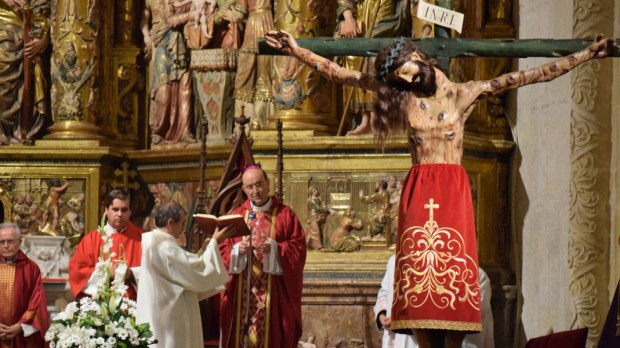The Cathedral of St. Mary of Burgos is the first gothic cathedral of the Iberian Peninsula. Built over a previous Romanic church of the early 11th century, its construction officially begun on July 20, 1221, and continued late into the 18th century, when the sacristy of the chapel of St. Thecla was finished.
While the building abounds in artistic and cultural treasures (Flemish triptychs, oil paintings from the 15th, 16th, and 17th centuries, fine goldsmith works, textiles, and documents, and the tomb of El Cid Campeador himself), one sculpture stands out above all others: the famous (in fact, legendary) Christ of Burgos.
Imagen del cuadro q regaló la Cofradia a la Comandancia de la #GuardiaCivil de Burgos en el acto de su Hermanamiento pic.twitter.com/WoaNqA39du
— Cofradía 7Palabras (@7PalabrasBurgos) May 19, 2016
Its impressive, lifelike realism is literally the stuff of legend. At some point, it was claimed its hair and fingernails needed frequent trimming and paring, and that the facial hair of the wooden statue also required a shave every eight days or so. In fact, the wooden body of the Christ is covered in skin-like leather to accentuate its realism.
However, those are not the most relevant stories woven around the Christ of Burgos. That of how the image got to Burgos is. Taking a look at it will help us decipher one of the most uncommon symbols found in Christian art: that of the egg. Eggs are not too common in Western Christian art. But the image of the Christ of Burgos shows some eggs at the very base of the Cross. How did these eggs get there?
A las 20:00 procesión #SabadodePasion#SemanaSanta2015#SSBurgos Salida desde la Parroquia d Nuestra Señora d Fátima pic.twitter.com/cm6wKeCP18
— Cofradía 7Palabras (@7PalabrasBurgos) March 28, 2015
Legend has it that a rich wool merchant from Burgos had promised the friars of the convent of St. Augustine to bring them a gift upon his return from a commercial trip to Flanders. As he was already making his way back to Spain, he realized he had forgotten his promise. The moment he remembered, he found a wooden box floating in the sea, containing the image. A seagull had nested at the base of the cross and laid its eggs there. Since then, the eggs became the symbol of the Christ of Burgos.
However, there seems to be more than a historical explanation for the presence of those eggs in this image.
In his classic Bestiary of Christ, Louis Charbonneau-Lassay explains the egg, like the seed, “contains a promise: that of a new life which will soon emerge.” It makes perfect sense that the egg is then understood as a symbol of hope, one of the three theological virtues, on which St. Augustine wrote, in his Sermon CV, 8:
“There remains hope, which in my opinion can be compared to the egg. For hope has not yet reached its goal; likewise the egg is something, but it is not yet the chicken.”
It makes sense that this Crucified Christ, which belonged to an Augustinian convent, included these eggs at the base of the cross, following this reflection from St. Augustine himself. These eggs express the highest of all hopes: that of the Resurrection of Christ after the sheer abandonment of Holy Friday, and that of the believer’s rebirth into a blessed life beyond death.

